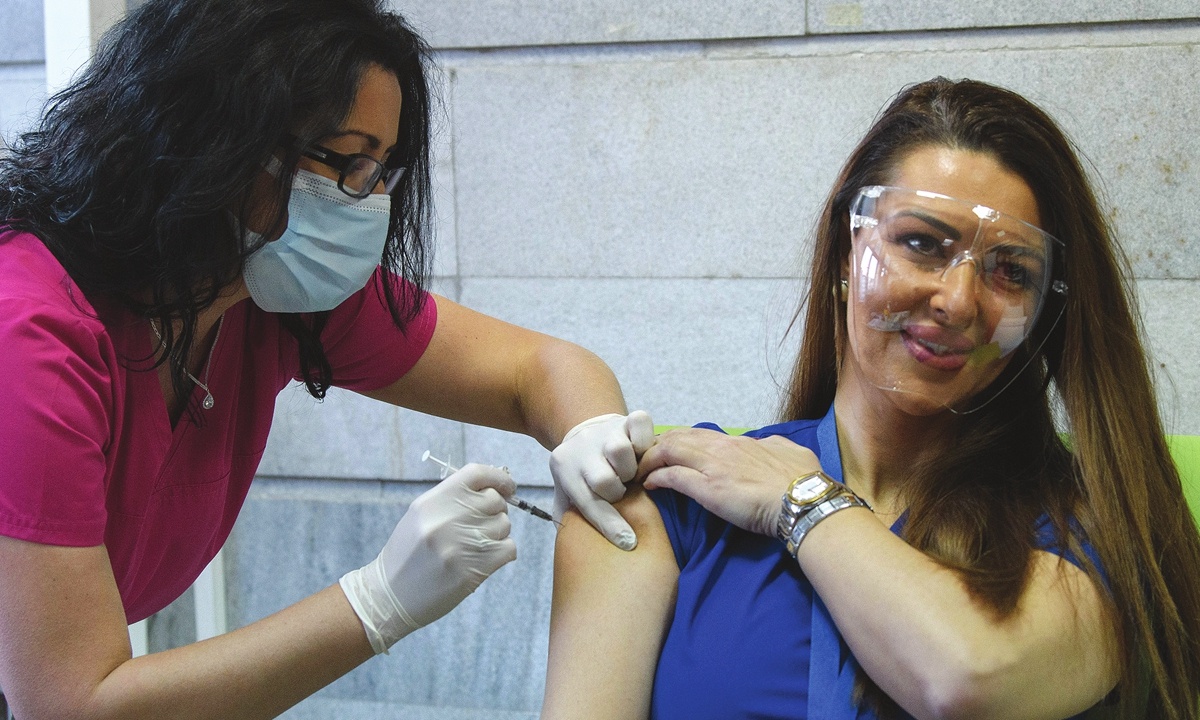
A medical worker receives an injection of the Moderna COVID-19 vaccine at the State University Hospital “Maichin Dom” in Sofia, Bulgaria on January 14. Photo: AFP
The development of COVID-19 mRNA vaccines may not have come so fast without the efforts of a scientist from China who has invested years in laying the groundwork.
Wang Nianshuang, a former research associate with the University of Texas at Austin, who has studied coronaviruses for years found his work became vital design of a synthetic spike protein of the mRNA vaccine developed by multiple developers including the Pfizer-BioNTech, Moderna, Johnson & Johnson and Novavax.
In a recent interview with the Global Times, Wang revealed how he helped in the development of the coronavirus mRNA vaccine.
Partnered with another professor at Tsinghua's medical school Zhang Linqi in 2012, Wang revealed the first human monoclonal antibody that can strongly neutralized the coronavirus that causes Middle East Respiratory Syndrome (MERS).
The revelation pave the way for a vaccine design that Wang and his team researched at McLellan Lab at the University of Texas to prevent MERS.
At least four of the COVID-19 vaccines showing promise around the world are using technology developed in Jason McLellan's lab, where Wang and his colleagues made contribution and shared the spike protein model with scientists globally, the Texas Tribune reported.
At McLellan's lab in 2016, Wang successfully found a way to lock the spike protein in order to ensure a more stable structure of the vaccine that can deliver accurate messages to human's immune system. The result, he said, can be applied to various coronaviruses that develop similar spike proteins.
The exploration was fraught with difficulties particularly at the beginning, as there were few previous studies to draw on. Wang almost attempted all methods to figure out spike protein structure in the early experiments.
Wang's finding was not fully appreciated. His works was repeatedly rejected by five mainstream science journals.
In 2016, the MERS outbreak has gradually disappeared, while SARS virus has no signs of a comeback, leaving the value of research results in the field of coronavirus seriously underestimated. But Wang did not give up and was convinced that this was an important investment.
Considering there have been two outbreaks of highly pathogenic coronavirus in just over a decade, Wang anticipated another coronavirus outbreak was very likely. Coronavirus research lagged far behind other viruses, such as HIV and influenza, with no vaccine or drug available at the time.
Building on previous research, Wang and colleagues released their restructure for the Sars-CoV-2 virus spike protein in the journal Science in February, 2020. They shared the newly designed structure with more than 100 labs and participated in vaccine development in cooperation with vaccine manufacturers such as Moderna. The cooperation largely boosted the vaccine's progress.
Wang suggested that, though a gap still existed, China's biopharmaceutical industry has developed rapidly in the past 10 years to reach the leading US and EU level. In particular, China's vaccine industry has become one of the fastest growing in the world.
When US accused hackers of trying to steal coronavirus vaccine data for China, Wang, as a Chinese who made technical contributions to vaccine R&D in the US, felt offended by such a politicized move.
"The university sent emails saying the FBI was investigating the matter, and a lot of Chinese professors advised me to hire a lawyer if I was involved," Wang recalled.
"It's still worrying as I do not know what kind of crazy things may happen to me," Wang told the Global Times.
Wang appealed to China to invest more in vaccine technology in the future to compete in global arena. Only when you are really strong can you gain more recognition and respect, he said, adding that Chinese vaccine companies should go global amid the COVID-19 pandemic.


